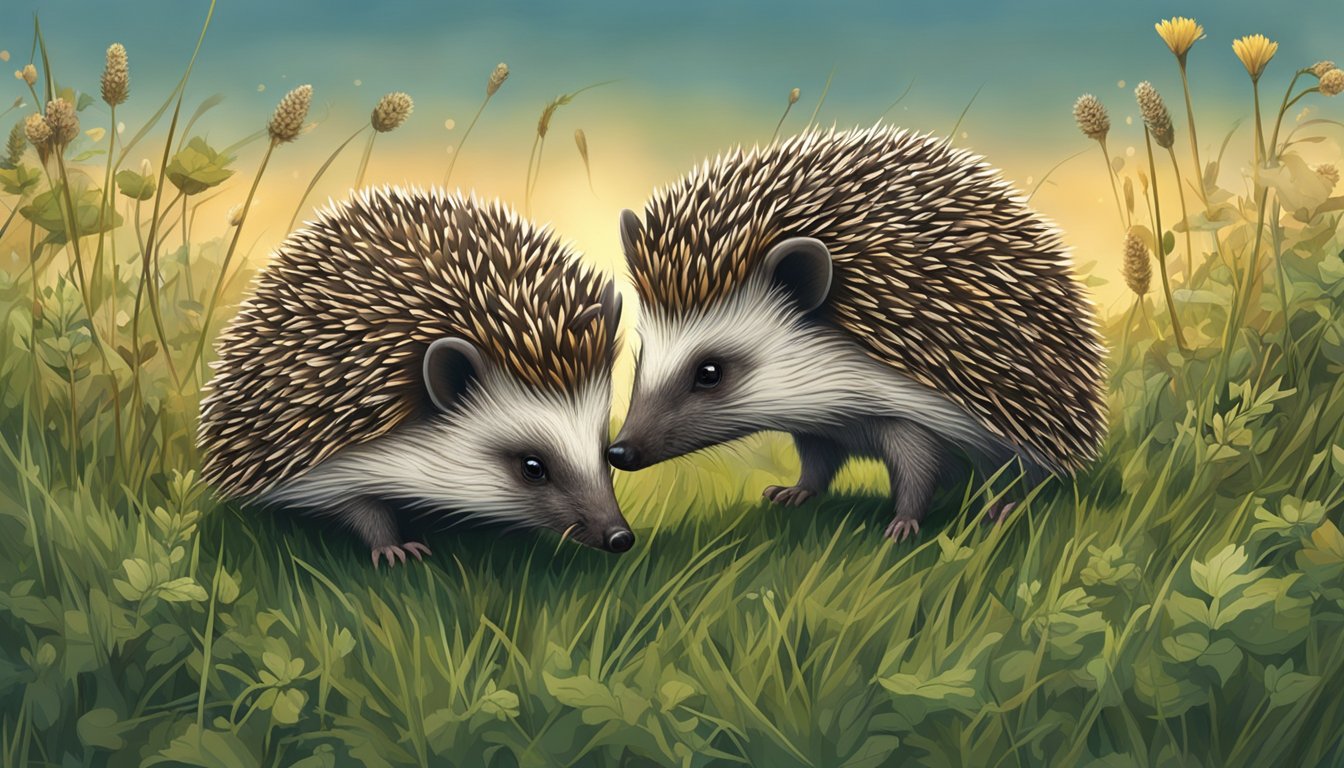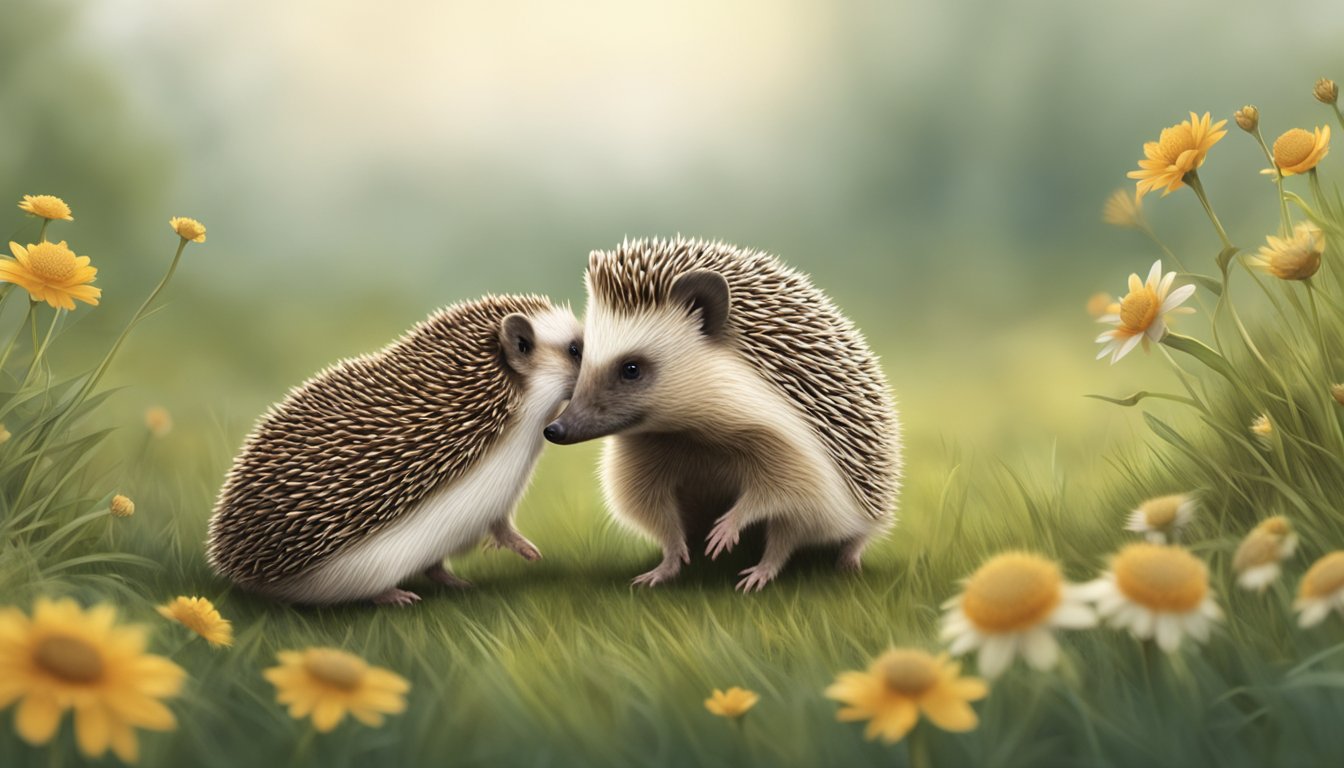Hedgehog mating typically occurs once the animals reach sexual maturity, usually in their second year of life. These nocturnal creatures engage in a unique mating ritual during the late spring and early summer months.
Their behavior includes a distinctive courtship dance often heard as a series of snuffles and grunts in the still night air. Interestingly, not all courtships result in mating, with many of these interactions not leading to reproduction.
The mating process for hedgehogs is solitary and brief; after mating, the male departs, leaving the female to manage pregnancy and rear the young alone. When successfully mated, the female hedgehog will carry her litter for around four to six weeks before giving birth.
Understanding these aspects of hedgehog behavior is critical to ensure their conservation and protection, as human activities often threaten their habitats.

Key Takeaways
- Hedgehogs mate in late spring and early summer after reaching sexual maturity in their second year.
- Courtship rituals are complex, but not all lead to successful mating.
- Understanding hedgehog mating is essential for their conservation and protection.
Understanding Hedgehog Mating Behavior
To fully appreciate the lifecycle of hedgehogs, it’s essential to understand their unique reproductive habits, which include distinct mating seasons and behaviors, and are influenced by environmental factors.
Mating Season and Courtship Rituals
Hedgehogs typically breed during the spring and sometimes again in September. Courtship is a delicate process that involves circling, grunting, and snuffling sounds by the male.
The male hedgehog will woo the female through rhythmic snorting and sometimes headbutting. This courtship behavior is crucial for the pair to progress to actual mating.
Mating Process and Hedgehog Interaction
As the old joke goes, “How do hedgehogs mate?” …. “Very carefully!”
Once the courtship is successful, the mating process involves the male hedgehog adopting a special body position to avoid harming the female with his spines, which are flattened during mating.
Hedgehog mating can be turbulent due to the presence of rival males or interlopers, leading to actions like chasing and the rut.

Reproductive Aspects of Hedgehogs
Females reach sexual maturity in their second year of life and can have one or two litters per year, each containing up to seven hoglets.
Hedgehogs are promiscuous creatures, with females often mating with several males, resulting in a pregnancy with a gestation period of around 35 days.
Influence of Environment on Mating
Their environment significantly influences hedgehog mating behavior. Quality foraging grounds and suitable nesting sites, such as hedgehog houses in gardens and urban areas, play crucial roles.
The breeding season can be compromised if hedgehogs are ill or underweight or if external conditions like food scarcity or extreme weather disrupt hibernation.
Challenges to Successful Mating
Challenges to successful hedgehog mating include insufficient weight to survive hibernation, lack of food and water in dry periods, and insufficient fat reserves pre-hibernation.
Hedgehogs may delay mating when food is short or if they are underweight, prioritizing survival over reproduction.
Life After Mating: Hedgehog Birth and Care
Following a successful mating, the female hedgehog embarks on a journey of nest-building, birthing, and nurturing her young. This section explores the critical stages from birth to weaning, underscoring mother hedgehogs’ tenacity and the hoglets’ growth trajectory.

Post-Mating Care and Birth
After mating, the female hedgehog begins the careful construction of a nursery nest to prepare for the arrival of her young. These nests often enlarge the hibernation nests known as hibernacula but are shaped to accommodate the hoglets.
Birth typically occurs approximately 35 days after mating, with litters ranging from 1 to 7 hoglets.
Rearing of the Young Hedgehogs
Mother hedgehogs are solitary in parenting – they rear the litter without the male’s assistance. The rearing process is crucial, and the mother hedgehog will frequently take foraging trips to gather enough food to produce milk for her hoglets. During this time, the mothers are fiercely protective of their nesting site.
Hedgehog Development Stages
The development stages of hoglets are rapid; they are born blind but gain sight after a few weeks. The weaning period starts around four weeks when they begin to explore solid food while still nursing.
By six weeks, hoglets are usually weaned, and they continue to grow and develop their foraging and hunting skills.
Factors Affecting Hedgehog Parenting and Survival
Numerous factors influence hedgehog parenting and survival rates. Predators, habitat loss in urban areas, and human disturbances can affect their safety and access to food.
Hedgehogs are solitary creatures, and surviving alone is challenging as they must hedge against dangers while mating, foraging, and rearing young.
Human Intervention in Hedgehog Care
While hedgehogs are wild animals, pet owners and gardeners can play a role in their care. Providing safe gardens free of hazards and with ample food can benefit hedgehogs.
In some cases, especially in rehabilitation or when hedgehogs are found in urban settings, human intervention with careful guidelines can support a hedgehog’s return to nature.
The Hedgehog Lifecycle Beyond Mating
Understanding the hedgehog’s life after the mating season is crucial to appreciating how they grow, adapt, and interact with the world around them.
From birth to hibernation and their encounter with human environments, each stage plays a significant role in the lifecycle of these solitary creatures.
From Hedgehog Birth to Adulthood
Hedgehogs usually give birth to up to six hoglets after a gestation period of around one month. Hoglets are born blind and are dependent on their mother for nourishment and protection. Over the following weeks, they develop spines, open their eyes, and explore their surroundings.
They continue growing and learning from their mother how to forage for food. Hedgehogs reach sexual maturity at around one year of age when they are fully capable of an independent life and can engage in the mating process themselves.
Hibernation and Its Impact on Reproduction
Hedgehogs usually enter hibernation in the winter months when food is scarce. This state of inactivity helps them conserve energy. Before hibernating, they must accumulate enough fat by eating various foods, such as insects, snails, and worms, which provide adequate nutrition.
Hibernation impacts the mating season as hedgehogs will mate after they emerge from this dormant period, usually in the spring when they can find ample food and water to support the energy demands of reproduction.
The Role of Diet and Environment in Hedgehog Longevity
A hedgehog’s diet primarily consists of insects, making them beneficial in gardens by helping control pest populations. Their longevity is influenced by the availability of food and water, as well as the safety of their habitat.
Hedgehogs can thrive in diverse environments but tend to avoid open areas. They favor undergrowth and gardens where they can forage and hunt without the threat of predators.
Table: Hedgehog Diet Components
| Food Type | Purpose |
|---|---|
| Insects | Essential for growth |
| Snails | Source of nutrition |
| Worms | Key for fat reserves |
| Fruit | Occasionally for variety |
| Water | Vital for hydration |
Interactions with Humans and Urban Environments
Human activity has both positive and negative impacts on hedgehogs. Hedgehogs often find refuge in urban areas and gardens, where they may benefit from supplementary feeding and water provided by residents.
However, they face dangers such as traffic, litter, and loss of natural habitat. Hedgehog-friendly practices in Britain include checking bonfires before lighting and creating hedgehog holes in fences to ensure safe passage between gardens.
These actions help hedgehogs navigate urban environments and contribute to their conservation.




Leave a Reply